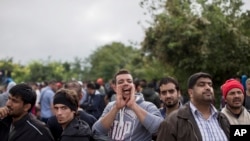Croatia lifted restrictions on the main border crossing with Serbia Friday, ending a week of friction prompted by the flow of thousands of migrants across their common frontier.
About 60,000 people escaping war and poverty in the Middle East and Africa have entered Croatia in recent days from its eastern neighbor Serbia, according to official figures released the same day.
Speaking in Belgrade, a visiting European Union commissioner, Johannes Hahn, said the migrant crisis is a global problem that can be resolved only through the joint engagement of all European countries.
EU President Donald Tusk said a “thread of understanding” was emerging among European leaders as they moved away from mutual recriminations and started to think about how to contribute to solving the crisis, while “protecting Europe from an excessive wave” of migrants and refugees.
Tusk spoke on Poland's state TVP Info following the EU summit that decided to toughen border controls and provide more funds to help refugees in the Middle East.
Hungarian Prime Minister Viktor Orban, however, said in Vienna that he would seek support for his country's efforts to block the flood of migrants at its southern border with Croatia, including sealing the border as Hungary did with Serbia. He spoke at a news conference after meeting with Austrian Chancellor Werner Faymann.
The Hungarian prime minister said that whatever action his country takes will be "transparent." Orban praised Serbia's cooperation with Hungary on dealing with the flood of migrants, but expressed doubts about Croatia’s compliance with EU rules on dealing with migrants and border controls.
Meanwhile, German officials said Friday that according to their estimates, 30 percent of asylum-seekers currently in their country are not citizens of war-torn Syria, as they claim, but from elsewhere.
On Thursday, the European Union announced its Mediterranean naval operation will enter the second phase of a three-part operation against migrant traffickers, beginning October 7.
Speaking Thursday at the Rome headquarters of the EU operation, the bloc’s foreign affairs chief, Federica Mogherini, announced the decision, saying, “The assets are ready."
The three-phase operation, launched at the end of June, includes the use of military force against migrant traffickers, the seizure of vessels used to transport people across the Mediterranean Sea, most of them departing from the coast of Libya, as well as disposal of vessels and related assets, preferably before use, and the apprehension of traffickers and smugglers.
Explaining the new phase, Mogherini said European warships will operate against traffickers, conducting searches, and, if necessary, diverting suspicious vessels, but only in international waters without entering Libyan territory.
The EU operation currently has four ships and several planes at its disposal.
